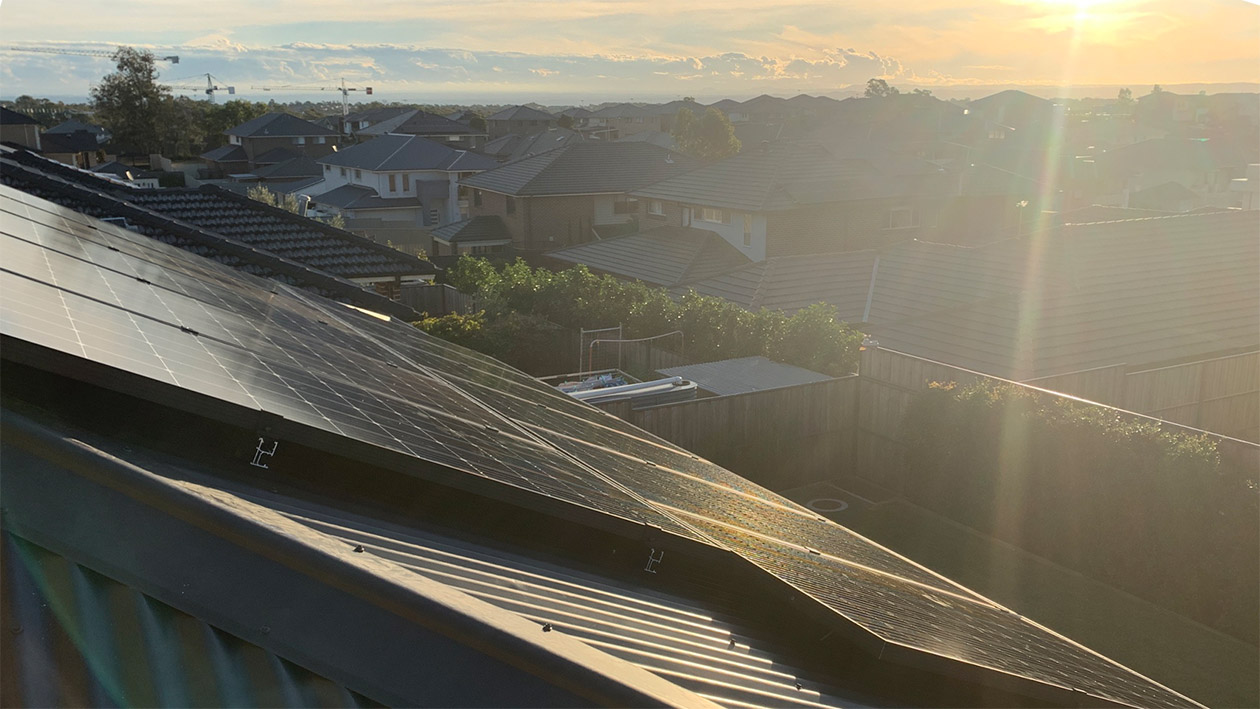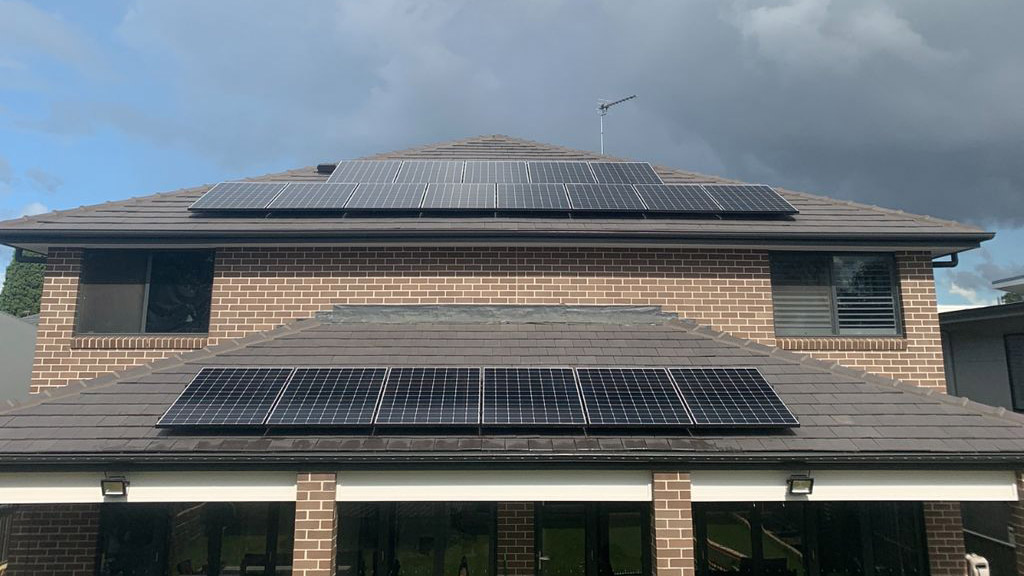Which Direction Should Solar Panels Face in Australia?

Installing solar panels is a significant investment towards a sustainable future. It allows you to harness renewable energy and reduce your reliance on traditional power sources. However, maximising the efficiency of your solar panels requires careful consideration, particularly regarding their direction. Solar panel direction directly impacts the amount of sunlight they capture, influencing your energy production and overall system performance.
What Factors Will Impact the Best Solar Panel Orientation for Me?
Several key factors influence the optimal direction for your solar panels, ultimately impacting your energy production and system performance:
- Geographic Location: Your location within Australia, specifically your latitude, is crucial in determining the best direction for your solar panels. Generally, in the southern hemisphere, a north-facing orientation allows panels to capture the most sunlight throughout the day as the sun tracks across the northern sky. However, slight adjustments based on your specific latitude can further optimize energy production.
- Roof Pitch: The angle of your roof, known as the pitch, affects how directly sunlight hits the panels. Ideally, the panels should be tilted at an angle equal to your latitude for maximum exposure. For example, if your latitude is 30 degrees, a 30-degree tilt would be optimal. However, roof pitch varies, and adjustments to the panel tilt might be necessary to find the best compromise between the roof angle and the ideal solar panel angle.
- Shading: Shading from nearby trees, buildings, or other obstructions can significantly impact your solar panel’s energy output. Even partial shading on a single panel can affect the performance of the entire system due to the way panels are connected. Therefore, performing a site assessment to determine potential shading throughout the day and throughout the year is crucial during the planning stage. Trimming trees or placing panels to avoid shade can significantly improve system efficiency.
- Time-of-Day Energy Needs: Consider when you typically use the most electricity. If your peak energy consumption occurs in the afternoon or evening, adjusting the panel angle slightly westward can optimise energy production during those periods. This adjustment takes advantage of the sun’s lower position in the western sky during the later parts of the day.
Understanding these factors and their interplay is crucial for maximising the efficiency of your solar panel system.
Which Solar Panel Direction Will Maximise Your Self-Consumption?
Choosing the right direction for your solar panels directly influences your ability to self-consume the generated energy, reducing reliance on the grid and maximising the benefits of your solar investment. Let’s explore how different orientations impact self-consumption within the Australian context:
North Orientation
- Ideal for consistent daytime energy use: North-facing panels in Australia consistently capture the most sunlight throughout the day, aligning well with typical household energy consumption patterns. This makes them ideal for homes with relatively even energy usage throughout the day.
- Maximises overall energy production: Due to the sun’s path across the northern sky in the southern hemisphere, north-facing panels receive the most direct sunlight for the longest duration, leading to the highest overall energy yield over the course of the year.
- Best for grid-tied systems with feed-in tariffs: If you are connected to the grid and receive feed-in tariffs for excess energy, a north-facing system will likely generate the most surplus energy to feed back into the grid, maximising your potential earnings
Luke Spicer, Clean Energy Approved Solar Installer from Skyline Solar offers this expert tip: “Don’t just assume north-facing is always best. Think about when you use the most electricity. If it’s in the evenings, a west-facing orientation might be more beneficial for maximising self-consumption and reducing reliance on the grid during peak hours.”
West Orientation
- Caters to afternoon/evening energy needs: West-facing panels are most productive in the afternoon and early evening, aligning with peak energy usage periods for many households during dinner preparation, lighting, and entertainment.
- Benefits during summer peak pricing: West-facing panels can be advantageous in regions with time-of-use electricity pricing as they generate more energy during peak price periods in the late afternoon and evening, particularly during summer. This can lead to greater cost savings.
- Suitable for solar battery systems: West-facing panels, when paired with a solar battery, can effectively store excess energy generated in the afternoon for use during evening peak times or overnight, further enhancing self-consumption and reducing reliance on the grid.
North-West Orientation
- Balances morning and afternoon production: A north-west orientation balances morning and afternoon energy generation, catering to homes with moderate energy consumption throughout the day and slightly higher usage in the late afternoon and early evening.
- A good compromise for diverse energy needs: This direction can be suitable for households with varying energy usage patterns, providing a more consistent energy supply throughout the day than a purely east or west-facing system.
East Orientation
- Captures morning sun for early energy needs: East-facing panels are most productive in the morning hours, making them ideal for homes with higher energy demands early in the day, such as for breakfast preparation, heating, or running appliances like washing machines and dishwashers.
- May not align with peak demand periods: The energy production from east-facing panels may not coincide with peak demand periods in the late afternoon and evening, especially during summer. This can limit self-consumption potential unless paired with a solar battery system for energy storage.
Did You Know? A study on Optimization of Solar Panel Orientation for Maximum Energy Efficiency found that optimizing solar panel orientation based on sunlight angle and shading factors can significantly boost energy efficiency and reduce climate change impacts [1].
North-East Orientation
- Provides balanced morning and midday generation: Similar to north-west, a north-east orientation offers a balance between morning and midday solar energy generation. This can be a good option for homes with relatively consistent energy usage throughout the daylight hours.
- Suitable for diverse energy needs: The balanced production profile of north-east facing panels can cater to a variety of household energy consumption patterns, providing a good compromise for those seeking consistent energy generation throughout the day.
East and West Orientation
- Extends energy production across the day: Installing panels on both east and west-facing roof sections can significantly extend energy production across a larger portion of the day, providing a more consistent energy supply.
- Requires larger system size: This approach often necessitates a larger system size to accommodate panels on both roof sections, which can increase upfront costs.
- Good for high daytime energy demands: East and west-facing systems are well-suited for homes with consistently high energy demands throughout the day, as they provide a more balanced and extended energy generation profile.
South Orientation
- Least recommended orientation in Australia: South-facing panels receive the least amount of sunlight throughout the year in the southern hemisphere, resulting in significantly lower energy output compared to other orientations. This makes them generally unsuitable for maximizing self-consumption and overall system efficiency, not to mention some difficulties in actually finding true south.
- May be suitable in specific scenarios: In rare cases where north-facing roof space is unavailable or severely limited, and energy needs are primarily during midday, south-facing panels might be considered. However, alternative options like ground-mounted systems or purchasing green power from the grid should be explored first.
Combining Directions
- Tailored to specific energy usage patterns: Combining different orientations, such as north and west or east and west, allows for a more customised approach to solar panel installation. This strategy can provide a more consistent energy supply throughout the day, aligning better with specific household usage patterns and potentially maximising self-consumption.
- Requires careful planning and design: Combining orientations requires careful planning and consideration of roof space, shading, and the desired balance of energy production throughout the day. Professional solar installers can assist in designing a system that optimises self-consumption based on individual needs.
- Enhances battery storage effectiveness: Combining orientations can further improve battery utilisation for homes with solar battery systems. By generating energy across a wider portion of the day, batteries can be charged more efficiently and provide a more consistent power supply during peak demand periods or outages.
Choosing the right direction for your solar panel install plays a crucial role in maximising self-consumption and achieving energy independence. By carefully considering your energy usage patterns, location, and roof configuration, you can select the optimal orientation or combination of orientations to harness the sun’s energy effectively and meet your household’s electricity needs.

Other Considerations for Optimal Solar Panel Placement
While direction plays a crucial role in solar panel efficiency, several other factors deserve consideration to ensure optimal performance and maximise your solar energy harvest:
- Ground-Mounted Systems:
- Flexibility in placement: Ground-mounted systems offer greater flexibility in terms of direction and tilt compared to roof-mounted systems. This allows for precise optimization based on your location and energy needs.
- Land requirements: Ground-mounted systems require suitable land space, which may not be feasible for all properties. Consider the available area and potential shading from surrounding structures or vegetation.
- Additional costs: Ground-mounted systems typically involve additional costs for foundations, mounting structures, and trenching for cabling, which can impact overall project budget.
- Tracking Systems:
- Increased energy production: Solar tracking systems follow the sun’s path throughout the day, maximizing energy capture compared to fixed-tilt systems. This can lead to a significant increase in energy production, especially in areas with consistent sunshine.
- Higher upfront costs: Tracking systems are generally more expensive than traditional fixed-tilt systems due to the added complexity and components involved.
- Maintenance requirements: Tracking systems have moving parts that require regular maintenance to ensure optimal performance and longevity.
- Local Regulations and Permits:
- Planning permissions: Check with your local council or relevant authorities regarding any planning permissions or permits required for solar panel installations. Regulations may vary depending on your location and system size.
- Grid connection approvals: If you plan to connect your solar system to the grid, ensure you obtain the necessary approvals and comply with local regulations and standards for grid-tied systems.
- Building codes and safety standards: Adhere to all relevant building codes and safety standards for electrical wiring, rooftop installations, and structural considerations. This ensures the safety and longevity of your solar panel system.
[1] Selvi, S., Mohanraj, M., Duraipandy, P., Kaliappan, S., Natrayan, L., & Vinayagam, N. (2023). Optimization of Solar Panel Orientation for Maximum Energy Efficiency. 2023 4th International Conference on Smart Electronics and Communication (ICOSEC), 159-162. https://doi.org/10.1109/ICOSEC58147.2023.10276287.

